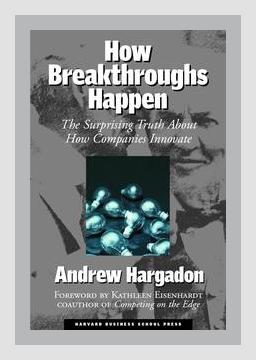Innovation and CreativityDisruptive Innovation
Introduction
Andrew Hargadon’s “How Breakthroughs Happen: The Surprising Truth About How Companies Innovate” challenges traditional notions about innovation, suggesting that significant breakthroughs often come from the recombination of existing ideas rather than radical new inventions. Drawing on historical examples, the author explores the concept of “technology brokering” where companies and individuals innovate by bridging different domains of expertise and repurposing old technologies in new ways.
Major Points and Actionable Advice
- Technology Brokering:
Major Point: Hargadon illustrates that breakthroughs often come from entities acting as brokers between different domains, recombining existing ideas to create new innovations.
Examples:
– Thomas Edison and the Menlo Park lab functioned as technology brokers, combining existing technologies like the telegraph key, vacuum pump, and telephone receiver to create the electric light bulb.
– IDEO, a design and consulting firm, brings together principles from different industries to create breakthrough products like the Palm V handheld device.
Actionable Advice: Widen your exposure to different fields and industries. Network with professionals from varied disciplines and encourage cross-functional collaboration within your teams to facilitate the flow of ideas.
- History Repeats Itself:
Major Point: Rather than focusing on novel inventions, successful innovators often look to the past for ideas that can be adapted and improved.
Examples:
– The development of the VCR borrowed heavily from earlier advances in audiotape recording.
– The modern personal computer took inspiration and components from mainframe and minicomputers.
Actionable Advice: Study historical technological advancements related to your industry. Identify outdated or abandoned ideas and explore how contemporary tools and knowledge can revitalize these concepts.
- Contexts for Innovation:
Major Point: Innovation thrives in environments that support free exchange and interaction among diverse ideas and perspectives.
Examples:
– The AT&T Bell Labs was an iconic research environment where open communication led to groundbreaking technologies like the transistor and laser.
– The Procter & Gamble “Connect + Develop” program encourages external collaborations to bring in fresh ideas.
Actionable Advice: Create spaces and opportunities for unstructured interaction within your organization, like informal meetings or social events. Foster an open culture where team members feel comfortable sharing ideas without fear of criticism.
- Persistence of Old Technologies:
Major Point: Old technologies don’t just disappear; they often find new applications and contribute to future innovations.
Examples:
– The QWERTY keyboard, originally designed to prevent typewriter jams, continues to be used in modern computers despite other potentially more efficient layouts.
Actionable Advice: Don’t dismiss old technologies outright. Evaluate their strengths and consider how they can be integrated with contemporary innovations for improved solutions.
- Building Innovation Networks:
Major Point: Companies and individuals that are well-connected in a variety of networks are more likely to be successful innovators.
Examples:
– The innovation at 3M was supported by a “15% time” policy, allowing employees to spend a portion of their work time exploring new ideas, leading to breakthroughs like Post-it Notes and masking tape.
Actionable Advice: Invest time in building relationships across different sectors and industries. Leverage platforms like conferences, online communities, and professional organizations to broaden your network.
- Learning from Failures:
Major Point: Failures are valuable learning opportunities that can provide insights leading to future successes.
Examples:
– The invention of the microwave oven came about when Raytheon engineer Percy Spencer noticed that radar waves had melted a candy bar in his pocket, showing accidental discovery leading to innovation.
Actionable Advice: Cultivate a mindset that views failure as a step towards progress. Encourage experimentation and risk-taking within your team, and establish processes for documenting and analyzing failures.
- Role of Leadership in Innovation:
Major Point: Effective leadership is essential for fostering an innovative culture by encouraging experimentation and rewarding creative efforts.
Examples:
– Steve Jobs at Apple created an environment that valued design and user experience, leading to groundbreaking products like the iPhone and iPad.
Actionable Advice: As a leader, promote a culture of innovation by providing resources, recognizing creative contributions, and sustaining a long-term vision that supports exploratory projects.
- Adopting an Experimental Approach:
Major Point: Innovation is an iterative process where small experiments and prototypes pave the way for larger developments.
Examples:
– Thomas Edison’s invention process was highly iterative, involving thousands of experiments to refine his ideas.
Actionable Advice: Implement a strategy of rapid prototyping and iterative testing. Create an environment where small-scale trials are easy to conduct and learn from.
- Customer Feedback in Innovation:
Major Point: Direct feedback from users is invaluable in guiding the innovation process.
Examples:
– The development of the Polaroid camera heavily relied on customer feedback to iterate and improve their product offerings.
Actionable Advice: Engage with your customers frequently through surveys, focus groups, and beta testing. Use their feedback to guide the development and refinement of your products and services.
-
Leveraging Technology Transfer:
Major Point: Innovations often emerge from transferring technologies across different contexts.Examples:
– The graphical user interface (GUI) was developed at Xerox PARC but became commercially successful through its adoption by Apple and later Microsoft.Actionable Advice: Be on the lookout for technologies in other sectors that can be adapted to your context. Collaborate with universities, research institutions, and other companies to explore technology transfer opportunities.
Conclusion
Andrew Hargadon’s “How Breakthroughs Happen” provides a rich framework for understanding innovation through technology brokering and leveraging existing ideas. The book’s insights and historical examples underscore that innovation is more about recombination and contextual adaptation than entirely new inventions. By embracing diverse networks, past technologies, an open culture, persistence, and customer feedback, individuals and companies can foster an environment where breakthroughs are more likely to occur.
